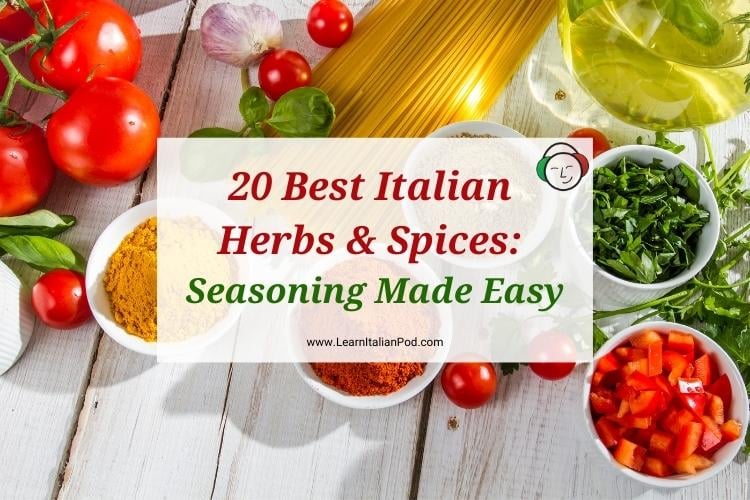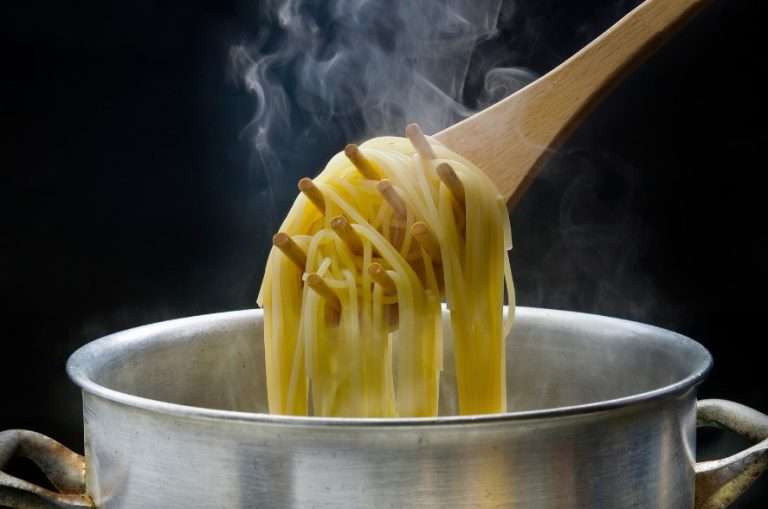20 Best Italian Herbs & Spices: Seasoning Made Easy
Ever wondered about the allure of Italian cuisine? The answer is steeped in the symphony of Italian herbs and spices that dress every dish.
Bursting with fragrant basil, robust rosemary, and an assortment of other seasonings, these ingredients morph modest meals into culinary masterpieces, embodying the essence of Italian cooking.
Imagine the fresh, peppery sweetness of basil enhancing a Caprese salad, a homemade pesto, or the rustic notes of rosemary elevating roasted meats and bread. Consider the layer of flavor oregano lends to pasta sauces and pizzas; this harmonious blend sets Italian cuisine apart.
You’ll discover spice blends in many grocery stores, including the popular Italian seasoning blend.
Usually composed of dried herbs, these Italian seasoning blends provide a convenient way to keep the essence of classic herbs and spices in a spice rack right at your fingertips, ready to invigorate your home cooking.
These blends are a testament to the ubiquitous use of homemade Italian seasoning, a medley of the herbs and spices we’re about to explore.
20 Must-Know Italian Herbs and Spices: The Ultimate List

Dive into the world of Italian cuisine with our comprehensive Italian herbs and spices list. The information we provide will guide you to curate your own Italian seasoning blend, tailoring these captivating flavors to your personal taste and imbuing your dishes with a unique touch.
1. Basilico (Basil)
Basil is an aromatic herb native to Asia but widely used in Italian cuisine. It is a staple in dishes like Caprese salad, pesto, and tomato-based sauces.
Basil adds a fresh, slightly sweet, and peppery flavor to the food, with hints of clove and anise. Its bright green leaves bring a pleasant aroma and a touch of Mediterranean essence to dishes.
Basilico: Quick Summary
- Recommended Pairings: Caprese salad, pesto, tomato-based sauces.
- Taste and Aroma: Fresh, slightly sweet, peppery flavor with hints of clove and anise. Bright green leaves provide a pleasant aroma.
2. Rosmarino (Rosemary)
Rosemary is a woody, evergreen herb native to the Mediterranean region. It pairs exceptionally well with roasted meats, such as lamb and chicken, as well as potatoes and bread. Rosemary imparts a strong, pine-like aroma and a robust, slightly bitter flavor to food, enhancing the overall savoriness of the dishes.
Rosmarino: Quick Summary
- Recommended Pairings: Roasted meats (lamb, chicken), potatoes, bread.
- Taste and Aroma: Strong, pine-like aroma. Robust, slightly bitter flavor that enhances savoriness.
Suggested Reading: Uncover the secrets of the best Italian kitchen brands: a journey into top design and elite style.
3. Origano (Oregano)
Oregano is a crucial herb in Italian cuisine, especially tomato sauces, pizzas, and grilled vegetables. It has a warm, aromatic, and slightly bitter taste.
Oregano’s origins trace back to the Mediterranean region. Its dried leaves provide a bold flavor reminiscent of earthy and floral notes, which adds depth to various Italian dishes. Of all the Italian herbs and spices, this is a must for Italian pizza lovers.
Origano: Quick Summary
- Recommended Pairings: Tomato sauces, pizzas, grilled vegetables.
- Taste and Aroma: Warm, aromatic, slightly bitter taste. Bold flavor with earthy and floral notes.
4. Salvia (Sage)
Sage is a herb native to the Mediterranean and widely utilized in Italian cuisine. It complements rich, hearty dishes like roasted meats, pasta fillings, and butter sauces.
Sage leaves have a slightly peppery and earthy flavor, along with hints of eucalyptus and citrus. When cooked, they develop a wonderful aroma and impart a robust, savory taste to the food.
Salvia: Quick Summary
- Recommended Pairings: Roasted meats, pasta fillings, butter sauces.
- Taste and Aroma: Slightly peppery, earthy flavor with hints of eucalyptus and citrus. Develops a robust, savory taste when cooked.
Curious about the culinary secrets of Italy? Dive into our article to uncover interesting Italian food facts that will leave you craving for more!
5. Prezzemolo (Parsley)
Parsley is a versatile herb used as a garnish, seasoning, or ingredient in numerous Italian dishes. It is essential to Italian salsa verde, marinades, soups, and salads.
This herb has a fresh, slightly bitter taste with hints of citrus and grassy notes. Its vibrant green leaves lend a visually appealing touch and a bright, herbaceous flavor to various culinary creations.
Prezzemolo: Quick Summary
- Recommended Pairings: Italian salsa verde, marinades, soups, salads.
- Taste and Aroma: Fresh, slightly bitter taste with hints of citrus and grassy notes. Bright, herbaceous flavor.
6. Aglio (Garlic)

Garlic (together with olive oil) is a fundamental ingredient in Italian cuisine, adding a distinct all-Italian flavor to countless dishes. Its aromatic and spicy taste is essential for creating bold and robust flavors, from pasta sauces and bruschetta to roasted meats and dressings.
Garlic’s origins can be traced back to Central Asia, and its cloves release a powerful aroma and a unique, umami-packed taste when minced or cooked. Embrace the flavorful essence of garlic powder, a convenient option to infuse the distinctive garlic flavor into various Italian recipes. An essential for all devotees of Italian herbs and spices.
Aglio: Quick Summary
- Recommended Pairings: Pasta dishes, bruschetta, roasted meats, garlic bread, and dressings.
- Taste and Aroma: Aromatic, spicy flavor. Adds bold, robust flavors. Powerful aroma when minced or cooked.
7. Peperoncino (Chili Pepper)
Peperoncino, also known as chili pepper, is an essential and omnipresent spice in Italian cuisine, especially in the vibrant culinary traditions of Southern regions.
These fiery red pepper flakes bring a fiery heat and a touch of liveliness to beloved Italian dishes like pasta arrabbiata, pizza, and a range of sauces, such as spaghetti sauce.
The versatility of these red chili flakes is evident in their various varieties, each with its own unique characteristics. From mild and fruity to blazingly intense, these chili pepper flakes contribute to a dish’s overall complexity and depth of flavors.
Peperoncino: Quick Summary
- Recommended Pairings: Pasta arrabbiata, pizza, tomato sauce.
- Taste and Aroma: Adds heat and vibrant flavor. Mild to fiery intensity, depending on the variety. Enhances the overall complexity of the dish.
8. Finocchio (Fennel)
Fennel, or finocchio, is a vegetable with aromatic seeds and delicate fronds widely used in Italian cooking. The fennel seeds are utilized in sausages, bread, and desserts, while the bulb and fronds are used in salads, soups, and braised dishes.
Finocchio (Fennel) imparts a sweet, licorice-like flavor and a mild herbal undertone to dishes. It adds a refreshing and sweet note, balancing the flavors and providing a unique Mediterranean touch.
Finocchio: Quick Summary
- Recommended Pairings: Sausages, bread, desserts, salads, soups, braised dishes.
- Taste and Aroma: Sweet, licorice-like flavor. Mild herbal undertone. Refreshing and provides a unique Mediterranean touch.
9. Dragoncello (Tarragon)
Tarragon, known as dragoncello in Italian, is a herb characterized by aromatic leaves and a subtle licorice flavor. It pairs exceptionally well with poultry, fish, and egg dishes.
This herb adds a delicate yet distinct herbal taste with hints of anise and vanilla. Its bright green leaves bring a touch of elegance to Italian recipes, elevating the overall culinary experience.
Dragoncello: Quick Summary
- Recommended Pairings: Poultry, fish, and egg dishes.
- Taste and Aroma: Delicate, subtle licorice flavor. Hints of anise and vanilla. Adds a touch of elegance and enhances the overall culinary experience.
10. Alloro (Bay Leaf)
Bay leaf, or alloro, is a popular herb used in Italian cuisine to infuse dishes with a deep and aromatic flavor. It is often incorporated into slow-cooked sauces, stews, and soups, providing a subtly bitter and slightly floral taste.
Bay leaves impart a rich, earthy essence, enhancing the dish’s overall complexity while adding a sweet touch.
Alloro: Quick Summary
- Recommended Pairings: Slow-cooked sauces, stews, soups.
- Taste and Aroma: Deep, aromatic flavor. Subtly bitter and slightly floral taste. Imparts a rich, earthy essence and adds a sweet touch.
11. Timo (Thyme)

Thyme is a fragrant herb originating from the Mediterranean. It is frequently used in Italian cooking, particularly in pasta sauces, roasted meats, and vegetable dishes.
For those exploring the vegan facet of this cuisine, there are also Italian vegan cookbooks that will teach you how to utilize herbs and spices, including thyme, to create the perfect plant-based Italian meal.
This Italian herb offers a delicate, slightly minty, and lemony taste. Its tiny leaves infuse a subtle earthiness, elevating the flavors of the ingredients it accompanies.
Timo: Quick Summary
- Recommended Pairings: Pasta sauces, roasted meats, vegetable dishes.
- Taste and Aroma: Delicate, slightly minty, lemony taste. Subtle earthiness that enhances flavors.
12. Prezzemolo Riccio (Curly Parsley)
Curly parsley, or prezzemolo riccio, is widely used for its decorative purposes and mild flavor. It is commonly utilized as a garnish for various Italian dishes, including pasta, salads, and meat preparations. Curly parsley offers a fresh and crisp taste, adding a hint of brightness and a pleasant herbal note to the presentation.
Prezzemolo Riccio: Quick Summary
- Recommended Pairings: Pasta, salads, and meat preparations.
- Taste and Aroma: Mild flavor. Fresh, crisp taste. Adds brightness and a pleasant herbal note to the presentation.
13. Menta (Mint)
Mint, or menta, is a refreshing herb commonly used in Italian cuisine to add a burst of coolness to both savory and sweet dishes. It is often paired with lamb, fruits, salads, and beverages such as the traditional Italian mojito, known as “mojito alla menta.”
Mint leaves bring a refreshing and slightly sweet flavor, with hints of citrus and a cool, menthol sensation.
Menta: Quick Summary
- Recommended Pairings: Lamb, fruits, salads, beverages.
- Taste and Aroma: Refreshing, slightly sweet flavor. Hints of citrus. Provides a burst of coolness and a cool, menthol sensation.
14. Zenzero (Ginger)
Ginger, or zenzero, is a versatile spice that adds a distinctive zing to Italian recipes. It is commonly used in both sweet and savory dishes, such as gingerbread, sauces, stir-fries, and marinades.
Zenzero (ginger) provides a warm, spicy, slightly sweet flavor profile and a subtle citrusy note. It adds depth and complexity to Italian cuisine, contributing a unique touch to various culinary creations.
Zenzero: Quick Summary
- Recommended Pairings: Gingerbread, sauces, stir-fries, marinades.
- Taste and Aroma: Warm, spicy, slightly sweet flavor. Subtle citrusy note. Adds depth and complexity to dishes.
15. Santoreggia (Summer Savory)
Summer savory, or santoreggia, is an herb known for its aromatic leaves and peppery taste. It is often used in Italian bean soups, vegetable dishes, stuffings, and herb blends. Summer savory imparts a delicate, savory flavor with hints of thyme and mint. Its addition brings a subtle warmth and herbaceous essence to the dishes, enhancing their overall savory profile.
Santoreggia: Quick Summary
- Recommended Pairings: Bean soups, vegetable dishes, stuffings, herb blends.
- Taste and Aroma: Delicate, savory flavor. Peppery taste with hints of thyme and mint. Brings a subtle warmth and herbaceous essence to the dishes.
16. Maggiorana (Marjoram)
Maggiorana, or marjoram, is a fragrant herb native to the Mediterranean region. It is widely used in Italian cuisine, particularly in meat dishes, tomato sauces, and herb blends.
Marjoram has a mild and slightly floral flavor, similar to oregano but milder and sweeter. It adds a delicate and aromatic touch to Italian recipes, enhancing the overall harmony of flavors.
Maggiorana: Quick Summary
- Recommended Pairings: Meat dishes, tomato sauces, herb blends.
- Taste and Aroma: Mild, slightly floral flavor. Delicate and aromatic. Enhances overall harmony of flavors.
17. Pepe (Black Pepper)

Pepe, or black pepper, is an essential spice in Italian cuisine, present in almost every dish. It adds a distinct heat and zest, along with earthy and floral notes. Black pepper pairs perfectly with pasta, meat, seafood, and vegetable dishes, enhancing their flavors and providing a spicy kick.
Pepe: Quick Summary
- Recommended Pairings: Pasta, meat, seafood, and vegetable dishes.
- Taste and Aroma: Distinct heat and zest. Earthy and floral notes. Provides a spicy kick and enhances flavors.
18. Sale (Salt)
Sale, also known as sea salt, is a fundamental ingredient in Italian cooking used to season and enhance the flavors of various dishes. It balances the tastes, brings out natural flavors, and is a crucial component in the overall seasoning of Italian cuisine.
Whether it’s pasta, sauces, soups, or meat preparations, salt is vital in enhancing the savory and umami notes, creating a harmonious balance and ensuring a well-rounded taste experience.
Sale: Quick Summary
- Recommended Pairings: Various dishes – pasta, sauces, soups, meat preparations.
- Taste and Aroma: Enhances flavors and brings out natural flavors. Fundamental for seasoning in Italian cuisine. Balances tastes and ensures a well-rounded taste experience.
19. Lauro (Bay Laurel)
Lauro, or bay laurel, is a herb that originates from the Mediterranean and is renowned for its aromatic leaves. It is commonly used in Italian cooking, particularly in slow-cooked dishes, stocks, and sauces.
Bay leaves lend a subtle, slightly bitter flavor with hints of eucalyptus and camphor. They add depth and complexity to Italian recipes, infusing them with a warm and aromatic essence.
Lauro: Quick Summary
- Recommended Pairings: Slow-cooked dishes, stocks, sauces.
- Taste and Aroma: Subtle, slightly bitter flavor. Hints of eucalyptus and camphor. Adds depth and complexity with warm and aromatic essence.
20. Ginepro (Juniper)
Ginepro, or juniper, is a spice native to the Italian Alps and widely associated with Italian cuisine, especially in preparing game meats and certain cured meats.
Juniper berries have a distinct pine-like aroma and a slightly sweet, woody flavor with a hint of citrus. They bring a unique and complex taste to dishes, enhancing the earthy and gamey notes while providing a subtle touch of sweetness.
Ginepro: Quick Summary
- Recommended Pairings: Game meats, cured meats.
- Taste and Aroma: Distinct pine-like aroma. Slightly sweet, woody flavor with a hint of citrus. Enhances earthy and gamey notes. Provides a subtle touch of sweetness.
Embarking on the journey of Italian herbs and spices, we find culinary treasures that sculpt the taste of Italian cuisine. From humble basil to robust rosemary, they all carry unique flavor profiles, making Italian food beloved worldwide.
The aromatic oregano, the gentle thyme, and the bold sage breathe life into dishes, igniting culinary exploration. These ingredients, each with a story linked to the Italian land, attest to the country’s culinary mastery. As you savor a pasta dish or a robust ragù, appreciate the symphony of these herbs and spices. Buon Appetito!
Suggested Reading:
- Feeling full after your Italian meal? Indulge your taste buds with these 10 top Italian digestifs.







